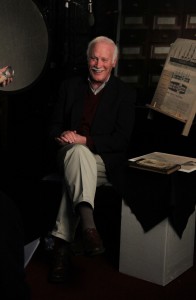
These modules provide greater details about certain aspects of the Society’s collections and activities. As with the main orientation film, we called upon our members and friends to describe on camera their own experiences with the Society. They prove to be wonderful witnesses of how the Society’s collections and programs can be transformative for people studying pre-twentieth century American history and culture. I worked with Larry Hott and Diane Carey of Florentine/Hott Productions to create these modules and the main orientation film. They have produced nearly two dozen films for national PBS broadcast and have won an Emmy, two Academy Award nominations, and a George Foster Peabody Award, among many others for their work.
In one module entitled “Accessing the Collections,” embedded below, AAS members William Fowler, Jill Lepore, and former fellows Ilyon Woo and Allison Stagg describe how extensive the online catalog is and how knowledgeable and helpful the AAS staff. In this same module, AAS counselor Bill Reese discusses the Society’s work in making digital facsimiles of the collection widely available. This segment also describes our online exhibitions.
The “Scholarly Programs” module seen below features AAS member Scott Casper and Allison Stagg describing how the Society has become a hub of scholarly endeavor and describes the activities of the Center for Historic American Visual Culture (CHAVIC) and the Program in the History of the Book in America.
“Fellowships” features Nathaniel Philbrick describing the collegial camaraderie he experiences whenever he conducts research at the Society. Jill Lepore describes how the fellowship she won early in her career gave her a sense of belonging to an intellectual community – a modern equivalent of the eighteenth century “community of letters.” And Honoree Jeffers describes her tenure as a Creative Fellow as a “leap forward” that opened up her worldview as an artist and a historian.
Local educator, Linda Forte, is featured in the “K-12 Programs” module below and she along with Scott Casper and Bill Fowler describe how the Society has involved pre-collegiate teachers from throughout Massachusetts and the nation in hands-on workshops that engage educators as scholars and ignites their passion for history and reinvigorates their teaching.
And this last module “Preservation” describes the work of our Conservation department. Here again Allison Stagg and Bill Fowler are featured. Allison describes the rare ephemera items now preserved by AAS despite their original intention to be viewed briefly and then discarded. Bill speaks of the beauty and value of actual artifacts and their need to be preserved.
I believe these modules provide additional insight into the workings of the Society and allow our members and friends the opportunity to share their great insights into what AAS has meant to them and their work. I hope you enjoy viewing them.

As a doctoral student who plans on applying for an AAS Fellowship in the future, I found these video modules provided a great deal of valuable information. Not only did I gain a better sense of the ways in which the AAS makes their ample resources available to burgeoning Americanist scholars, I learned from first hand accounts that the AAS actively fosters a tightly knit academic community–the value of which cannot be overestimated in the highly competitive world of “publish or perish.”
Well done, and thank you.
wow that room in the second video is amazing. very grand